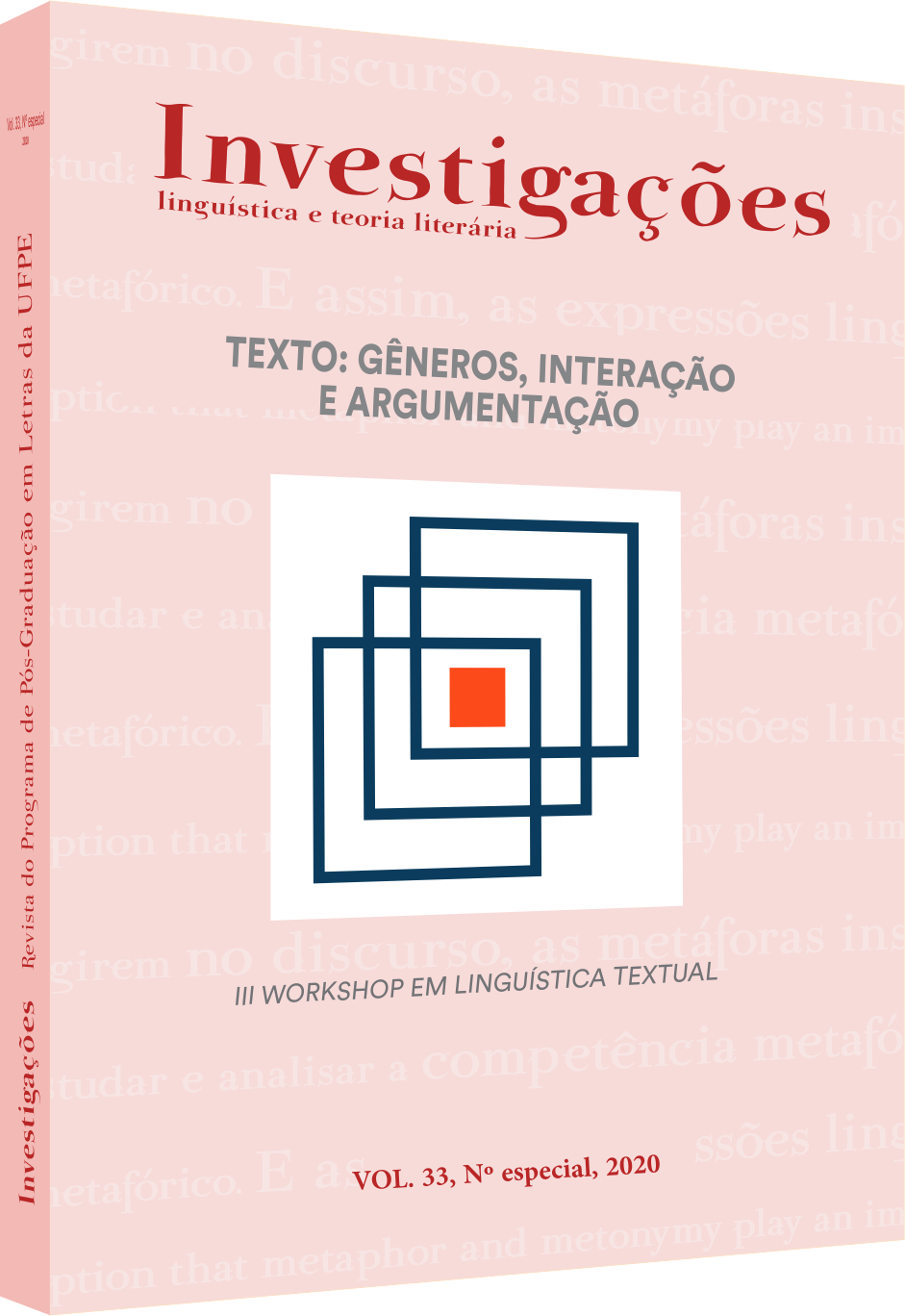Movimentos intertextuais na configuração do plágio
DOI:
https://doi.org/10.51359/2175-294x.2020.244472Keywords:
linguística textual, intertextualidade, plágio.Abstract
This paper discusses an intertextual constitution of plagiarism. The assumptions supported by Christofe (1996), Cavalcante and Brito (2011), Nobre (2014) and Koch (2009) use as an example or plan activities of intertextual movements that are typical of other intertextual processes (quote, paraphrase, parody and pastiche) to manifest. This reality provides multiple practical ways to organize the disguise of the plagiarism text and maintain the source text. An analysis compares a text accused of plagiarism with its source text, demonstrating, based on functional and constitutional norms (NOBRE, 2014), how this phenomenon can be composed through the intertextual movements of the parody.References
CABRAL, Sérgio. Antonio Carlos Jobim: uma biografia. Rio de Janeiro: Lumiar, 1997.
CAVALCANTE, Mônica Magalhães. Os sentidos do texto. São Paulo: Contexto, 2012.
CAVALCANTE, Mônica Magalhães; BRITO, Mariza Angélica Paiva. Intertextualidades, heterogeneidades e referenciação. Linha D'Água, v. 24, n. 2, p. 83-100, 2011.
CHRISTOFE, Lilian. Intertextualidade e plágio: questões de linguagem e autoria. 1996. 192f. Tese (Doutorado em Linguística). Universidade Estadual de Campinas, Instituto de Estudos da Linguagem, Campinas, SP, 1996.
FARIA, Maria da Graça dos Santos. Alusão e citação como estratégias na construção de paródias e paráfrases em textos verbo-visuais. 2014. 118 f. Tese (Doutorado em Linguística). Programa de Pós-graduação em Linguística, Universidade Federal do Ceará, Fortaleza, 2014.
GENETTE, Gérard. Palimpsestos: a literatura de segunda mão. Extratos traduzidos por Cibele Braga; Erika Viviane Costa Vieira; Luciene Guimarães; Maria Antônia Ramos Coutinho; Mariana Mendes Arruda; Mirian Vieira. Belo Horizonte: Viva Voz, 2010.
JENNY, Laurent. A estratégia da forma. In: JENNY, Laurent. Poetique. Revista de Teoria e Análise Literária. Livraria Almedina: Coimbra, 1979. p. 05-49.
KOCH, Ingedore Grunfeld Villaça. Introdução à Linguística Textual: trajetória e grandes temas. 2. ed. São Paulo: Martins Fontes, 2009.
KRISTEVA, Julia. Introdução à semanálise. Tradução de Lucia Helena França Ferraz. São Paulo: Perspectiva, 2005.
NOBRE, Kennedy Cabral. Critérios classificatórios para processos intertextuais. 2014. 128 f. Tese (Doutorado em Linguística). Programa de Pós-graduação em Linguística, Universidade Federal do Ceará, Fortaleza, 2014.
PIÈGAY-GROS, Nathalie. Introduction à l’intertextualité. Paris: Dunod, 1996. Traduzido por Mônica Magalhães Cavalcante; Mônica Maria Feitosa Braga Gentil; Vicência Maria Freitas Jaguaribe. São Paulo: Interseções, 2010.
SANT’ANNA, Affonso Romano de. Paródia, Paráfrase & Cia. 7. ed. São Paulo: Ática, 2003.
SOUZA SANTOS, José Elderson de; BRITO, Mariza Angélica Paiva; CAVALCANTE, Mônica Magalhães. Plágio, gêneros discursivos e sanções sociais. Revista Investigações, Recife, v. 32, n. 2, p. 571-602, 2019.
SOUZA SANTOS, José Elderson de; CAVALCANTE, Mônica Magalhães. O plágio sob uma ótica textual-discursiva. In: I Jornada de Linguística Textual: Diálogos em Estudo da Linguagem, 2019, São Luís. Anais... São Luís: I Jornada de Linguística Textual: Diálogos em Estudo da Linguagem, 2019. p. 296-309.
SOUZA SANTOS, José Elderson de; NOBRE, Kennedy Cabral. Intertextualidades explícitas e intertextualidades implícitas. Signótica, v. 31, 2019.
Downloads
Published
How to Cite
Issue
Section
License
Copyright (c) 2020 José Elderson de Souza-Santos, Aurea Suely Zavam

This work is licensed under a Creative Commons Attribution 4.0 International License.
Authors who publish with Revista Investigações agree to the following terms:
Authors retain copyright and grant the journal right of first publication with the work simultaneously licensed under the Creative Commons Attribution 4.0 International (CC BY 4.0) license that allows others to share the work with an acknowledgement of the work's authorship and initial publication in this journal.
Authors are able to enter into separate, additional contractual arrangements for the non-exclusive distribution of the journal's published version of the work (e.g., post it to an institutional repository or publish it in a book), with an acknowledgement of its initial publication in this journal.
You are free to:
Share — copy and redistribute the material in any medium or format for any purpose, even commercially.
Adapt — remix, transform, and build upon the material for any purpose, even commercially.
The licensor cannot revoke these freedoms as long as you follow the license terms.
Under the following terms:
Attribution — You must give appropriate credit , provide a link to the license, and indicate if changes were made . You may do so in any reasonable manner, but not in any way that suggests the licensor endorses you or your use.
No additional restrictions — You may not apply legal terms or technological measures that legally restrict others from doing anything the license permits.

